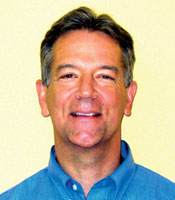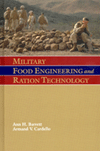
Doug Kindred, Chief Technology Officer, EAU Technologies Inc., Atlanta.
EO water makes its industrial debut
A double shot of high- and low-acid rinses is common practice in beef-side washing, reflecting the belief that microbes may be resistant to one pH extreme, but not both. Acidic solutions can be costly, however, which is why a technology used in carpet cleaning is so appealing. By combining salt and water with an electrical charge in a cell, positive and negative ions of water are created. Atlanta-based EAU Technologies Inc. has devised a commercial-scale unit that uses a membrane to separate these two fluid streams, one acidic with a pH of about 2.5 and the other alkaline at 11.5. Known as electrolyzed oxidative (EO) water, the technology recently entered commercial use at an upstate New York poultry operation.As in ozone generation, molecules are split with an electric charge, with hypochlorous acid forming on the positive side with chlorine from the salt and sodium hydroxide forming on the negative side. While EO is not as oxidative as ozone, it does not dissipate as quickly either, and can be stored in tanks for several hours without significant deterioration.
Helping shepherd EO to industrial use is Doug Kindred, EAU’s chief technology officer. Kindred joined the company in 2001, after 20 years in engineering and management. He holds a BS degree in mechanical engineering from Georgia Tech and is an executive program graduate of the University of North Carolina’s Kenan-Flagler Business School.

EAU’s Chris Anderson makes a pH adjustment on the HMI controlling an electrolyzed water generator. The system was being shipped to Kenya for use in the floral industry. Source: EAU Technologies Inc.
Kindred: Electrolyzed water was exploding in Japan in the 1990s as a very effective carpet cleaner when two Utah entrepreneurs acquired an EO generator. They did some preliminary research with professors from Brigham Young University, but they were spending more and more time in Georgia, which is the carpet capital of the world. That led to a relationship with Dr. Yen-Con Hung at the University of Georgia. I had done design/build work in the power industry for 18 years, and they hired me to build a prototype of an EO cell that could deliver the kind of volume that a commercial application would require.
FE: EO has been tested for raw oyster decontamination, in dairy CIP systems and for poultry processing. Is EAU involved in all those applications?
Kindred: Oysters are not a priority now. Finding new applications isn’t an issue for a start-up company; the challenge is keeping a focus. Other firms are pursuing medical uses, such as a treatment for diabetic ulcers, and a Japanese firm makes a generator for use with ice machines. In Japan, some people drink the alkaline water as an antioxidant. We don’t advocate that, but we are pursuing an oddball dairy application.
If you replace cows’ regular drinking water with this alkaline water, their stomachs metabolize food more efficiently, and milk quality and volume increase. The effect is similar to the impact of growth hormones, but without harming the cows. We have installed commercial watering systems at a dairy with a herd of about 100 milking cows, plus two larger-scale operations with up to 1,400 head.
FE: What was the state of the technology when you got involved?
Kindred: The generators for home use were capable of producing half a gallon a minute. The first challenge was to generate 50 gallons a minute for an industrial application. The next question was, how do we make a system robust enough to run 15,000 hours before failure? Finding the best materials for the different components and selecting pumps, piping, wiring and other parts that will withstand abuse is the engineering challenge of any project like this.
FE: How costly is the technology?
Kindred: We want to maintain control, so we don’t sell the machines. Instead, we do a full-service lease and do all the piping, wiring and everything else, from soup to nuts. The operating costs are electricity and cheap salt. The efficiencies we’ve been able to engineer into the system have allowed us to double the amount of EO water we generate with capital costs that have remained the same.
Early on, I ganged together 56 small cells to increase the gallons-per-minute production rate. Now, a single cell generates up to 90 gallons a minute. The unit weighs 500 lbs., and if more flow is needed, additional cells run in tandem.
FE: How much technical expertise is needed to utilize the technology?
Kindred: There are three buttons on the machine: stop, start and emergency stop. Operators have to monitor the water softener that feeds to the machine, but that’s it. If the system were so complicated that an engineer had to be on the floor, no one would apply the technology.
Ensuring that the system is delivering drinking water to cows in a field was a must. It’s a harsh environment, and we needed a way to monitor the system and perform diagnostics and repairs if something happened at 2:30 in the morning. Most operators are paranoid about anyone coming in through their network, so the control panel is equipped with a cell phone card. If there’s an alarm, we get a text message and can troubleshoot the problem remotely.
FE: What water temperature parameters are required?
Kindred: Although the water is heated for carpet cleaning, EO is not temperature-sensitive when used as a sanitizer or antimicrobial. EO can be applied at whatever temperature the incoming water arrives. In plants where there is an interest in reducing the carbon footprint, that’s an advantage.
FE: The first commercial application at a poultry plant was announced in the spring. How is EO water being used there?
Kindred: One of our earliest pilot applications was with Murray’s Chicken, using cells that generated half a gallon of EO a minute. The results were very positive, but we were a little ahead of the market. Since then, USDA’s Food Safety and Inspection Service has announced a sampling program that requires poultry processors to limit the ratio of carcasses testing positive for Salmonella to 10% to meet Category One requirements. The regulatory change is creating demand for new interventions, and because Murray’s produces an all-natural, higher-grade chicken, they were very interested in a non-toxic solution.
The system was installed in Murray’s South Fallsburg, NY facility and is used at multiple application points. At the scalder, the high pH water cleans the birds and loosens the feathers, making it easier to remove them. The key application is post-evisceration in the inside/outside bird washer. Since it’s been applied, there have been zero sampled carcasses with Salmonella. Farther down the line, EO is being sprayed on conveyor belts and other points that can be contaminated. At night, the acid and alkaline water is used to clean the plant.
“Green” technology is so overused, but this is a green product. Bacteria don’t develop a resistance, eliminating the need to rotate nine or 10 chemical biocides. Sodium hydroxide opens up the cell walls, and the hypochlorous acid explodes them.
FE: How do you ensure the system delivers an effective dosage?
Kindred: Incoming water has to be softened sufficiently for the electrolysis process to work, so maintaining the water softener is important. We have to be able to clean the dirtiest, nastiest birds that come into a poultry plant, so an efficacious concentration and sufficient contact time at the application point are critical. Since the acid rinse is a type of chlorine, a dose of 50ppm is the limit for direct food contact. Even at that level, EO is more effective than chlorine at 250ppm.

